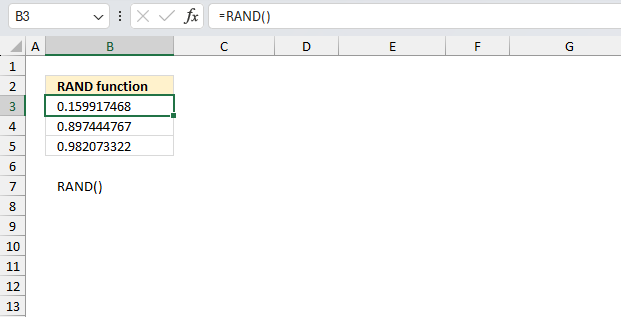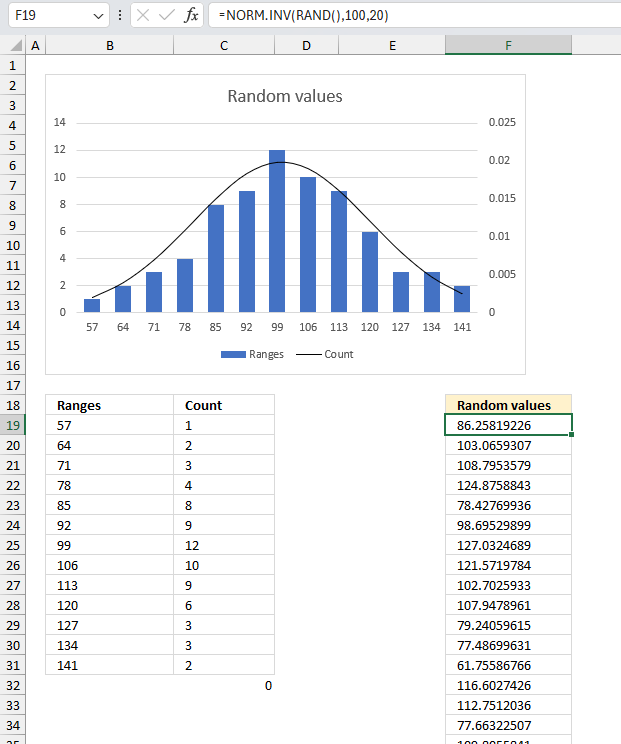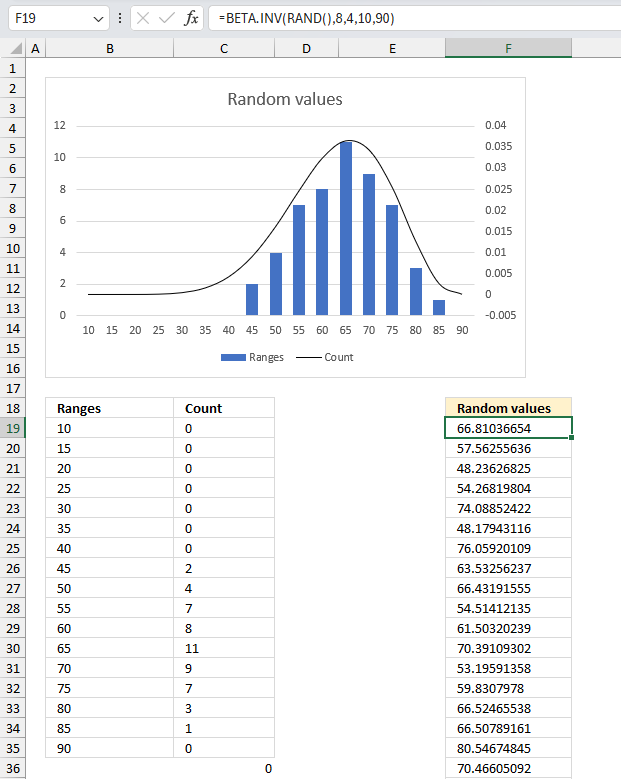How to use the RAND function

What is the RAND function?
The RAND function calculates a random real number greater than or equal to 0 and less than 1. The function is volatile.
Table of Contents
1. Introduction
What is random?
Each outcome of a random process cannot be predicted with certainty before it occurs. It is unpredictable.
Is the RAND function random?
No, it is pseudo-random. The generated value is not truly random.
What is pseudo-random?
Random numbers created by software like Excel are not truly random, they can be predicted. That is why they are called pseudo-random meaning they look like random values but they are not.
What is volatile?
The function is volatile meaning a new random real number is returned every time the worksheet is calculated.
What is the effect of volatile functions?
They may slow down your worksheet/workbook if you have many volatile functions.
When is the worksheet calculated?
Cells containing non volatile functions are only calculated once or until you force a recalculation, however, volatile functions are recalculated each time you type in a cell and press enter.
Can you stop recalculating a worksheet?
Yes, you can change a setting to manual recalculations.
- Go to tab "Formulas".
- Press with left mouse button on the "Calculation Options" button, a popup menu appears.
- Press with mouse on "Manual".
This stops the automatic recalculations.
How to force a recalculation?
Pressing F9 key will recalculate or refresh all the formulas and values in every worksheet of every workbook you have open.
Pressing Shift+F9 will only recalculate the formulas and values on the single worksheet you're currently viewing or active.
Pressing Ctrl+Alt+F9 is the quickest way to force a full recalculation of absolutely everything in all open workbooks, even if nothing has changed. It ignores whether changes were made or not and completely recomputes.
Are there more volatile functions in Excel?
Yes. OFFSET, TODAY, NOW among others.
| Function | Syntax | Description |
|---|---|---|
| OFFSET | OFFSET(reference, rows, cols) | Returns a cell offset from a reference cell. |
| TODAY | TODAY() | Returns the current date. |
| NOW | NOW() | Returns current date and time. |
| RANDARRAY | RANDARRAY([rows], [columns], [min], [max], [whole_number]) | Returns an array with random numbers. |
| RANDBETWEEN | RANDBETWEEN(bottom, top) | Returns a random whole number between bottom and top |
Note, that conditional formatting is extremely volatile or super-volatile meaning it is recalculated as you scroll through a worksheet.
What other functions return random values?
| Excel Function | Syntax | Description |
|---|---|---|
| RAND() | RAND() | Returns a random decimal number between 0 and 1 |
| RANDBETWEEN | RANDBETWEEN(bottom, top) | Returns a random whole number between bottom and top |
| RANDARRAY | RANDARRAY([rows], [columns], [min], [max], [whole_number]) | Returns an array with random numbers. |
2. Syntax
RAND()
The RAND function has no arguments.
3. Example 1

This basic example demonstrates what the RAND function outputs. The image above shows the RAND function in cells B3:B5, the output is a pseudo-random real number between 0 (zero) and 1.
Formula in cell B3:
The output values changes every time a new value is entered in any cell, this is why the function is a volatile function meaning it recalculates every time the worksheet recalculates. The RAND function takes no arguments, however you are still required enter the parentheses.
4. Example 2

A company is analyzing the distribution of customer wait times for their service. They've modeled the wait times using a normal distribution with a mean of 100 seconds and a standard deviation of 20 seconds. Use Excel's NORM.INV function with a random probability to generate a set of sample wait times. What is the distribution of these wait times, and how does it compare to the expected normal distribution?
What we can derive from the question:
- Random data follows a normal distribution.
- Mean: 100 seconds
- Standard deviation: 20
Formula in cell F19:
The formula in cell F19 and cells below returns random values based on a mean of 100 and a standard deviation of 20. A table to the left of the chart (columns A and B) showing the ranges and their corresponding counts. The table is a frequency table that contains the count based on ranges 57 to 141.
The image above shows a combination chart containing a column chart and a line chart. The blue columns represent the calculated distribution from source range B19:C31 and the black curve represents the normal probability density function.
The histogram shows a roughly bell-shaped distribution, with the peak around the 92-99 range, which aligns with the mean of 100 and standard deviation: 20 specified in the NORM.INV function. This charting technique allows us to compare the distribution to the expected normal distribution and find differences that may be problematic.
5. Example 3

A company is modeling the time it takes for customers to complete an online purchase process. They believe the completion times follow a beta distribution scaled between 10 and 90 minutes, with shape parameters α=8 and β=4. Use Excel's BETA.INV function with random probabilities and generate a set of sample completion times. What is the distribution of these completion times, and how does it compare to the expected beta distribution?
What we can derive from the question:
- Random data follows a beta distribution.
- shape parameter: α = 8 (alpha)
- shape parameter: β = 4 (beta)
- Lower limit: 10 [A]
- Upper limit: 90 [B]
The BETA.INV function has the following arguments: BETA.INV(probability,alpha,beta,[A],[B])
Formula in cell F19:
The formula in cell F19 and cells below returns random values based on a mean of 100 and a standard deviation of 20. The frequency table in cell range B19:C31 contains the count based on ranges 57 to 141.
The image above shows a combination chart containing a column chart and a line chart. The blue columns represent the calculated distribution from source range B19:C31 and the black curve represents the BETA probability density function.
The histogram shows a right-skewed distribution, with the peak around the 65-70 range, which is consistent with the beta distribution parameters given. The distribution is bounded between 10 and 90, with no values outside this range, reflecting the scaling parameters in the BETA.INV function.
This charting technique allows us to compare the distribution to the expected normal distribution and find differences that may be problematic.
6. Function not working

The RAND function returns a #NAME? error if you misspelled the function.
6.1 Troubleshooting the error value

When you encounter an error value in a cell a warning symbol appears, displayed in the image above. Press with mouse on it to see a pop-up menu that lets you get more information about the error.
- The first line describes the error if you press with left mouse button on it.
- The second line opens a pane that explains the error in greater detail.
- The third line takes you to the "Evaluate Formula" tool, a dialog box appears allowing you to examine the formula in greater detail.
- This line lets you ignore the error value meaning the warning icon disappears, however, the error is still in the cell.
- The fifth line lets you edit the formula in the Formula bar.
- The sixth line opens the Excel settings so you can adjust the Error Checking Options.
Here are a few of the most common Excel errors you may encounter.
#NULL error - This error occurs most often if you by mistake use a space character in a formula where it shouldn't be. Excel interprets a space character as an intersection operator. If the ranges don't intersect an #NULL error is returned. The #NULL! error occurs when a formula attempts to calculate the intersection of two ranges that do not actually intersect. This can happen when the wrong range operator is used in the formula, or when the intersection operator (represented by a space character) is used between two ranges that do not overlap. To fix this error double check that the ranges referenced in the formula that use the intersection operator actually have cells in common.
#SPILL error - The #SPILL! error occurs only in version Excel 365 and is caused by a dynamic array being to large, meaning there are cells below and/or to the right that are not empty. This prevents the dynamic array formula expanding into new empty cells.
#DIV/0 error - This error happens if you try to divide a number by 0 (zero) or a value that equates to zero which is not possible mathematically.
#VALUE error - The #VALUE error occurs when a formula has a value that is of the wrong data type. Such as text where a number is expected or when dates are evaluated as text.
#REF error - The #REF error happens when a cell reference is invalid. This can happen if a cell is deleted that is referenced by a formula.
#NAME error - The #NAME error happens if you misspelled a function or a named range.
#NUM error - The #NUM error shows up when you try to use invalid numeric values in formulas, like square root of a negative number.
#N/A error - The #N/A error happens when a value is not available for a formula or found in a given cell range, for example in the VLOOKUP or MATCH functions.
#GETTING_DATA error - The #GETTING_DATA error shows while external sources are loading, this can indicate a delay in fetching the data or that the external source is unavailable right now.
6.2 The formula returns an unexpected value

To understand why a formula returns an unexpected value we need to examine the calculations steps in detail. Luckily, Excel has a tool that is really handy in these situations. Here is how to troubleshoot a formula:
- Select the cell containing the formula you want to examine in detail.
- Go to tab “Formulas” on the ribbon.
- Press with left mouse button on "Evaluate Formula" button. A dialog box appears.
The formula appears in a white field inside the dialog box. Underlined expressions are calculations being processed in the next step. The italicized expression is the most recent result. The buttons at the bottom of the dialog box allows you to evaluate the formula in smaller calculations which you control. - Press with left mouse button on the "Evaluate" button located at the bottom of the dialog box to process the underlined expression.
- Repeat pressing the "Evaluate" button until you have seen all calculations step by step. This allows you to examine the formula in greater detail and hopefully find the culprit.
- Press "Close" button to dismiss the dialog box.

There is also another way to debug formulas using the function key F9. F9 is especially useful if you have a feeling that a specific part of the formula is the issue, this makes it faster than the "Evaluate Formula" tool since you don't need to go through all calculations to find the issue..
- Enter Edit mode: Double-press with left mouse button on the cell or press F2 to enter Edit mode for the formula.
- Select part of the formula: Highlight the specific part of the formula you want to evaluate. You can select and evaluate any part of the formula that could work as a standalone formula.
- Press F9: This will calculate and display the result of just that selected portion.
- Evaluate step-by-step: You can select and evaluate different parts of the formula to see intermediate results.
- Check for errors: This allows you to pinpoint which part of a complex formula may be causing an error.
The image above shows cell reference B3 converted to hard-coded value using the F9 key.
Tips!
- View actual values: Selecting a cell reference and pressing F9 will show the actual values in those cells.
- Exit safely: Press Esc to exit Edit mode without changing the formula. Don't press Enter, as that would replace the formula part with the calculated value.
- Full recalculation: Pressing F9 outside of Edit mode will recalculate all formulas in the workbook.
Remember to be careful not to accidentally overwrite parts of your formula when using F9. Always exit with Esc rather than Enter to preserve the original formula. However, if you make a mistake overwriting the formula it is not the end of the world. You can “undo” the action by pressing keyboard shortcut keys CTRL + z or pressing the “Undo” button
6.3 Other errors
Floating-point arithmetic may give inaccurate results in Excel - Article
Floating-point errors are usually very small, often beyond the 15th decimal place, and in most cases don't affect calculations significantly.
'RAND' function examples
Functions in 'Math and trigonometry' category
The RAND function function is one of 62 functions in the 'Math and trigonometry' category.
How to comment
How to add a formula to your comment
<code>Insert your formula here.</code>
Convert less than and larger than signs
Use html character entities instead of less than and larger than signs.
< becomes < and > becomes >
How to add VBA code to your comment
[vb 1="vbnet" language=","]
Put your VBA code here.
[/vb]
How to add a picture to your comment:
Upload picture to postimage.org or imgur
Paste image link to your comment.
Contact Oscar
You can contact me through this contact form